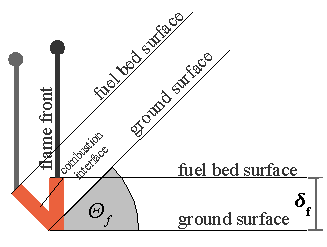

| Fire Behavior Variables |

|

|
What variables influence fire behavior?
The following variables are important determinants of fire behavior:
Although the influence of each variable on fire behavior is complex due to nonlinear interactions between variables, several generalizations are made for each variable in the sections below. A good source of general information on this subject is the book written by Pyne, et al. (1996).Fuels is the name given to the suite of variables used to describe the vegetation the fire is spreading through. A complete fuels description includes measurements of load (mass per unit area), heat content (energy per unit mass), surface-area-to-volume ratio, height, and moisture content. More information about fuels is available here.
| Assuming all other conditions are equal, the rate of spread of a fire increases as slope increases. The figure to the right depicts fire spreading through two fuel beds, one is level and one is inclined. As the fuel bed is tilted, the distance between the flame and an unignited fuel particle ahead of the flame decreases. Consequently, more radiative heat energy reaches the same fuel particle in the tilted fuel bed in comparison to the level fuel bed. This results in more rapid heating of the fuel particle and ultimately, a faster rate of spread. |

|
In general, south-facing slopes receive more direct sunlight throughout the day in comparison to north-facing slopes. This has two effects on fire spread. First, microenviromental conditions favor the production of more biomass on north-facing slopes, increasing the amount of available fuel. This does not always translate into increased rates of spread; beyond a certain threshold the additional fuel acts as a heat sink and slows the rate of combustion. Second, the ambient fuel temperature on a southwest-facing slope will be significantly higher in the late afternoon because of the increased radiant solar energy received by fuels at these aspects. As a result, the fuel particles on southwest-facing slopes are already at an elevated temperature and require less energy to be raised to their ignition temperature.
The three components of weather which influence fire spread are the wind speed, wind direction, and moisture present in the fuel. Like slope, the rate of fire spread increases as the wind speed increases. This effect is attributed to three factors. First, the wind induces a forward lean of the flame front, which reduces the distance between the flame and and the unignited fuel. Second, increased wind speed also increases the rate of convective heat transfer between the heated air and the unignited fuel particles. Third, wind passing through the interior of the fuel bed speeds the loss of moisture in the fuel particles, reducing the energy required for ignition. All of these effects are greatest in the prevailing direction that the wind is blowing. The moisture content of the fuels is also considered a weather-related variable because of its' similarly dynamic nature. The fuel moisture of living material such as leaves, foliage, and branchwood is regulated by the host plant to which it is attached, and will vary on a seasonal basis as the plant goes through the phenological cycle of flowering and growth through to senesecence. Unlike live fuel moisture, the fuel moisture of dead biomass, either suspended within the plant or lying along the ground, will vary diurnally according to the ambient temperature and humidity. Increased values of fuel moisture, both live and dead, contribute to reduced rates of fire spread because additional energy is required to vaporize the liquid and bring the respective fuel particles to igniton.
|
|